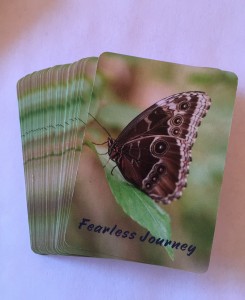Can Scrum Really Work Miracles? Take a Fearless Journey and Find Out
“That is just the way things are around, best to get used to it.”
“If you could fix that, things would really change around here, but that won’t ever happen.”
“If it were up to me, I would let you visit the end users, but it is not me you have to convince.”
At some point every Team member, ScrumMaster and Product Owner has heard those words (or their common variations) at some point using Scrum. Hear those words often enough and over time they diminish an individual’s engagement and passion. What these sad refrains have in common is that a good-natured person with their heart in the right place is trying to change things beyond their sphere of control, meeting resistance and being turned aside. What is needed is a way to create a collection of strategies which will successfully influence people to join the change agent in their to make things better. What they need is someone to join them on their Fearless Journey.
 I first encountered Fearless Journey (which is based on the change patterns found in the book Fearless Change) last Fall when I attended my consultant’s retreat on Agile Chartering. My friend Deb Hartmann Preuss introduced me to this simple game. Immediately, I found the whole idea intriguing because the game was just a simple deck of playing cards. The key difference is that instead of having hearts, spades, diamonds, kings, queens and jacks, the Fearless Journey deck has forty-six of the change patterns from the book printed on them.
I first encountered Fearless Journey (which is based on the change patterns found in the book Fearless Change) last Fall when I attended my consultant’s retreat on Agile Chartering. My friend Deb Hartmann Preuss introduced me to this simple game. Immediately, I found the whole idea intriguing because the game was just a simple deck of playing cards. The key difference is that instead of having hearts, spades, diamonds, kings, queens and jacks, the Fearless Journey deck has forty-six of the change patterns from the book printed on them.
One note before we begin the explanation of the game, if what the participants of the game want to change is within their control, then Fearless Journey is not for them. In these cases, I suggest using a technique called Circles and Soup from Diana Larsen. Fearless Journey works best when the object of change is outside the direct control of the participants.
Before dealing out the cards from the deck, the game facilitator will help the players brainstorm for six to eight minutes to identify anywhere from five to ten obstacles, impediments or challenges confronting them. In this stage, it is very common for the participants to focus on their current day-to-day challenges – some type of delay, poor quality of something or another, lack of adherence to this standard or that. Generally, the list of impediments will be something very tactical and tangible for the participants. That is fine since when you ask people what is bothering them, they tell you what is on their mind. Hopefully, the players will recognize some commonality in their impediments and\or duplication. The key is to find an obstacle that all of them face. Use this obstacle for the next stage.
The next step is a little tricky, so pay attention. Fearless Journey is about helping the participants go from their current reality to a new reality where their world has changed dramatically. Not only have they solved their common impediment but all the little problems they identified are gone as well – a miracle has happened. The facilitator asks the participants, “So what would have changed in order for this miracle to have occurred?”
Usually, there is a moment of silence (or a few people object to the use of magic), then the ideas start flowing and this where the facilitator needs to listen carefully. Almost always the facilitator needs to keep probing and ask the miracle question again, “So if they agreed to X, what miracle would have had happened then?” or “What miracle would have happened for everyone to see the impact of Y?”
Keep asking until you get someone to say, “If that happened, I better start looking for a new job” and everyone laughs. Or someone might say, “If you could make that miracle happen, I’d give you a million dollars” and everyone laughs. When you get to the laughter, you know you are close to your objective. Once you unearth that dark, gallows laughter – the laughter of disbelief – you know you have found the new reality the players are searching for, the reality the eliminates all the obstacles in front of the players. A reality that none of the players think is possible, but a reality Fearless Journey is specifically designed to help them see is really possible. This new reality is the destination for their Fearless Journey.
Once you get to that goal, write it on a post-it note and on another post-it note write, “Now” (or “Today”). On one end of the table, place the post-it note that says “Now” and about five feet away place the post-it with their future, aspirational goal. In a second round of brainstorming, ask the players to identify between four to eight obstacles, one per post-it note, blocking them from reaching their new reality. This process normally goes fairly quickly, but be careful the players do not engage in too much problem solving at this step. All we want is a list. When they have completed making their list of impediments, ask the participants to place the post-it notes in a line between “Now” and their future state. This line now represents all the obstacles in their way of their Fearless Journey.
This article is getting a bit long, so I will publish a follow-up article to review the game mechanics.

